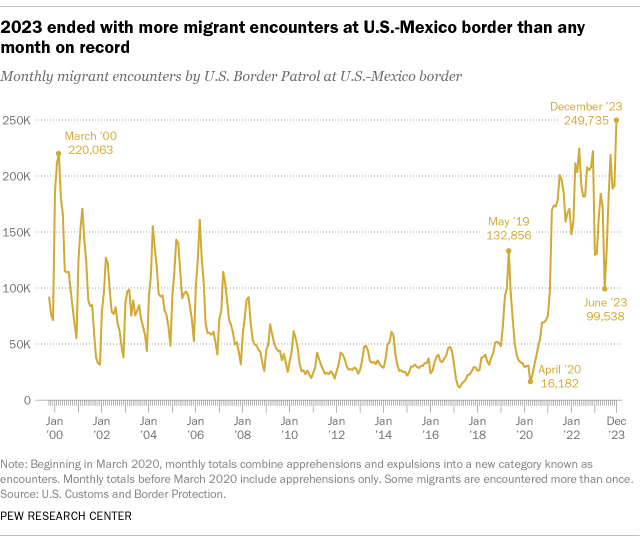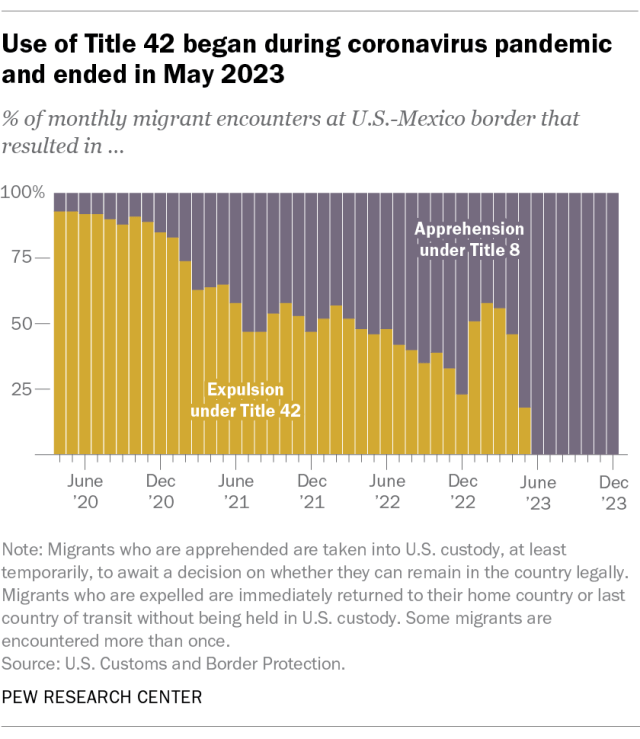The U.S. Border Patrol had nearly 250,000 encounters with migrants crossing into the United States from Mexico in December 2023, according to government statistics. That was the highest monthly total on record, easily eclipsing the previous peak of about 224,000 encounters in May 2022.

The monthly number of encounters has soared since 2020, when the coronavirus pandemic temporarily forced the U.S.-Mexico border to close and slowed migration across much of the world. In April 2020, the Border Patrol recorded around 16,000 encounters – among the lowest monthly totals in decades.
This Pew Research Center analysis examines migration patterns at the U.S.-Mexico border using current and historical data from U.S. Customs and Border Protection, the federal agency that includes the U.S. Border Patrol. The analysis is based on a metric known as migrant encounters.
The term “encounters” refers to two distinct types of events:
- Apprehensions: Migrants are taken into custody in the United States, at least temporarily, to await a decision on whether they can remain in the country legally, such as by being granted asylum. Apprehensions are carried out under Title 8 of the U.S. code, which deals with immigration law.
- Expulsions: Migrants are immediately expelled to their home country or last country of transit without being held in U.S. custody. Expulsions are carried out under Title 42 of the U.S. code, a previously rarely used section of the law that the Trump administration invoked during the early stages of the COVID-19 pandemic. The law empowers federal health authorities to stop migrants from entering the country if it is determined that barring them could prevent the spread of contagious diseases. The Biden administration stopped the use of Title 42 in May 2023, when the federal government declared an end to the COVID-19 public health emergency.
It is important to note that encounters refer to events, not people, and that some migrants are encountered more than once. As a result, the overall number of encounters may overstate the number of distinct individuals involved.
This analysis is limited to monthly encounters between ports of entry involving the Border Patrol. It excludes encounters at ports of entry involving the Office of Field Operations.
Since then, the monthly number of migrant encounters at the U.S.-Mexico border has surpassed 200,000 on 10 separate occasions. That threshold previously hadn’t been reached since March 2000, when there were about 220,000 encounters.
It’s not clear whether the recent high numbers of encounters at the border will persist in 2024. In January, encounters fell to around 124,000, according to the latest available statistics.
The term “encounters” refers to two distinct types of events:
- Apprehensions: Migrants are taken into custody in the U.S., at least temporarily, to await a decision on whether they can remain in the country legally, such as by being granted asylum. Apprehensions are carried out under Title 8 of the U.S. code, which deals with immigration law.

- Expulsions: Migrants are immediately expelled to their home country or last country of transit without being held in U.S. custody. Expulsions are carried out under Title 42 of the U.S. code, a previously rarely used section of the law that the Trump administration invoked during the early stages of the COVID-19 pandemic. The law empowers federal health authorities to stop migrants from entering the country if it is determined that barring them could prevent the spread of contagious diseases.
In the early months of the pandemic in the U.S., the Border Patrol relied heavily on Title 42 to expel most of the migrants it encountered at the border. The Biden administration stopped the use of Title 42 in May 2023, when the federal government declared an end to the COVID-19 public health emergency. Since then, the Border Patrol has been apprehending migrants within the U.S. instead of expelling them from the country.
Who is crossing the U.S.-Mexico border?

In December 2023, most encounters at the U.S.-Mexico border (54%) involved migrants traveling as single adults, while 41% involved people traveling in families and 5% involved unaccompanied minors.
In recent months, a growing number of encounters have involved people traveling in families. In December 2023, the Border Patrol had nearly 102,000 encounters with family members, up from around 61,000 a year earlier.
There has also been a shift in migrants’ origin countries. Historically, most encounters at the southwestern border have involved citizens of Mexico or the Northern Triangle nations of El Salvador, Guatemala and Honduras. But in December 2023, 54% of encounters involved citizens of countries other than these four nations.

Venezuelans, in particular, stand out. Nearly 47,000 migrant encounters in December 2023 involved citizens of Venezuela, up from about 6,000 a year earlier. The number of encounters involving Venezuelans was second only to the approximately 56,000 involving Mexicans in December 2023.
There has also been a sharp increase in encounters with citizens of China, despite its distance from the U.S.-Mexico border. The Border Patrol reported nearly 6,000 encounters with Chinese citizens at the southwestern border in December 2023, up from around 900 a year earlier.
How do Americans view the situation at the border?
The American public is broadly dissatisfied with how things are going at the border, according to a new Pew Research Center survey.
Eight-in-ten U.S. adults say the government is doing a very or somewhat bad job dealing with the large number of migrants seeking to enter the U.S. at the border with Mexico. And nearly as many say the situation is either a “crisis” (45%) or a “major problem” (32%) for the U.S.
Note: This is an update of a post originally published on March 15, 2021.



